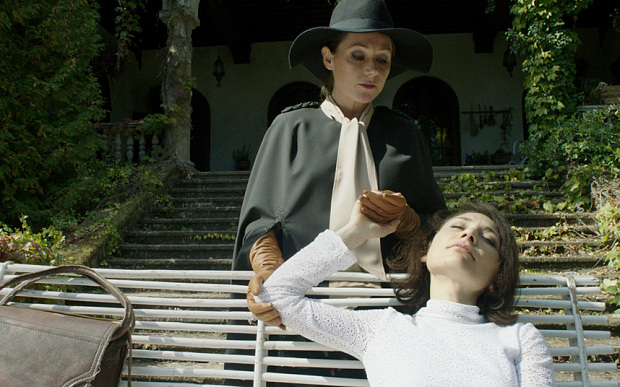As children, our imaginations are fostered and fuelled by fairytales. The illusion of adulthood is that we stop pursuing such fantasies. The Duke of Burgundy proves fantasy is too important and too dangerous to be left to children. As presented here, it’s a necessary adjunct to fully-realised love, even when you already live in a fantasy world.”
Peter Strickland’s previous film, Bergman-esque giallo homage Berberian Sound Studio, saw Toby Jones’ sound engineer getting drawn into a tortuous job on an Italian slasher film, and in turn suffering an identity crisis. Identities shift once more in The Duke of Burgundy. Initially, the film seems to centre on Chiara D’Anna’s timid housemaid Evelyn, who is in the stern employ of butterfly expert Cynthia (Borgen’s Prime Minister, Sidse Babett Knudsen). Evelyn arrives for duty, polishing floors and washing underwear, but when Cynthia finds fault with her efforts, punishment ensues. Out with the sweeping brushes and in with the S&M gear! Despite this sub-Tinto Brass setup, we slowly learn that the dominant and submissive roles in this relationship are prone to switching. This switching of identities plays into the film’s larger game of equating adult fantasizing with childhood play and innocence. The material is heady and stunningly erotic, but it’s all presented as genteel, even reassuring. The film opens with a portrait straight from a childhood idyll. Evelyn is seated by a rippling brook in an autumnal wood, when a butterfly lands on her hand. This harmonious image will shortly be put to bed, as this little naïf is slowly revealed to be anything but. The film’s title refers to a breed of butterfly, but it’s not just bugs that metamorphose in the world of The Duke of Burgundy.
Like the best fantasies, many of The Duke of Burgundy’s individual peculiarities are accepted as fact. The novelty of Cynthia and Evelyn’s relationship comes not from any lesbian stereotyping, but from the fantastical elements both within and around the pair. These sleeping beauties live in a world inhabited solely by women. Taking the conceit of Fassbinder’s The Bitter Tears of Petra von Kant one step further, men are never alluded to; this world of women simply is. The couple inhabit a castle-like mansion, full of antiques and creaking floorboards. Most everyone in this world studies butterflies, with academic lectures proving the social highlight of all and sundry. These habits and rigours are never explained, and they never need to be. We’re too focused on our central couple. D’Anna’s piercing eyes and high-tuned voice convey innocence, while Knudsen’s sultry tones put her firmly in charge. It’s to their credit that they sell the plot developments, as Strickland pulls the carpet out from our expectations. It’s a bait-and-switch recalling Mulholland Drive, another masterful tale of transformative lesbianism and destructive fantasies. Strickland knows their back-and-forth is the key to The Duke of Burgundy and, with two striking performances at his film’s core, he’s able to construct any fantasy he wishes around it. They guarantee an emotional connection even when the film’s bizarre sense of humour comes to the fore. You’d be amazed how emotionally involved you become about the purchase of a human toilet.
Mercifully, we never see a human toilet onscreen, but the suggestion is enough to arouse interest. For all the kinky goings-on, not one errant nipple or pubic hair is glimpsed. The greatest fantasies come from what remains hidden, yet the film is too emotionally charged and too beautiful to be reduced to a tease. Strickland never resorts to cheap thrills; instead, he fills his womanly world with unexpected sights and sounds. The film is shot in warm textures; night is more navy than black, and every room is lit by lamplight. Like some ASMR-fuelled fever dream, the gentlest noises are accentuated, be it rippling water, creaking hinges or zipping up leather boots. A soundscape of whispers and harpsichords is all part of the reassuring fairytale, never eclipsed by bawdy leeriness and never getting in the way of the struggles of our central couple.
As time passes, Evelyn’s heightened sexual demands begin to take their toll on submissive and dominant alike. In one of the film’s most remarkable scenes, a nightmare appears to take place between Cynthia’s legs, culminating in the screen being filled by the deafening flapping of butterfly wings. The Duke of Burgundy is full of surprises, just not the type you’d expect from an S&M-driven romance. The kinkiness comes amidst a heightened sensory experience; the opening credits include a ‘Perfume by…’ credit. Everything in this film’s production, from its visuals to its elegant camerawork to its sound design, is engineered for seduction. That said, despite the leather boots and domination, it all comes back to the childish side of fantasy. Unlike so much other violently insistent erotica, The Duke of Burgundy is gentle and welcoming. It creates a spell over its audience, allowing the vapours to soak in before delivering a few sharp whip cracks. It’s seductive, sensuous and sublime; drink it in.

